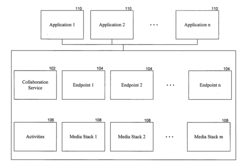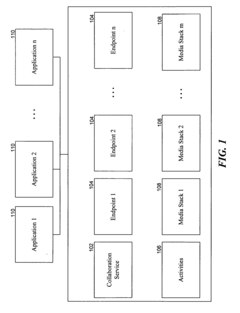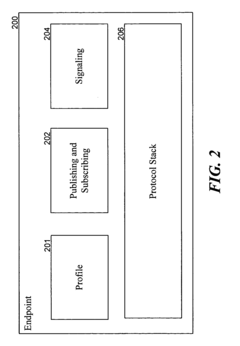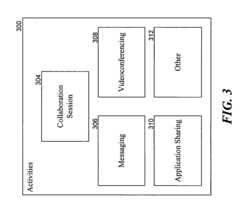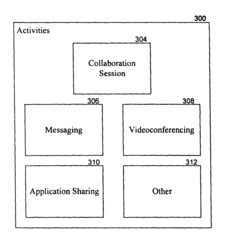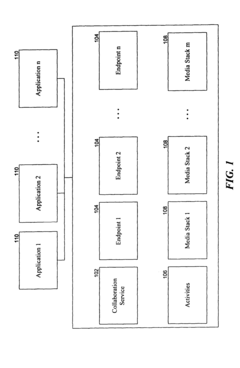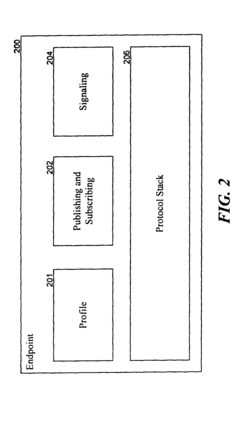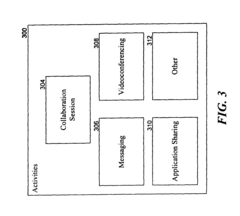How 5G UC Facilitates Real-Time Collaboration in Architecture and Design
JUL 18, 20259 MIN READ
Generate Your Research Report Instantly with AI Agent
Patsnap Eureka helps you evaluate technical feasibility & market potential.
5G UC in Architecture: Background and Objectives
The evolution of 5G technology has ushered in a new era of connectivity, with 5G UC (Ultra-Capacity) standing at the forefront of this revolution. In the realm of architecture and design, 5G UC presents unprecedented opportunities for real-time collaboration, transforming the way professionals conceptualize, create, and execute projects. This technological advancement builds upon the foundations laid by previous generations of mobile networks, offering enhanced speed, reduced latency, and increased capacity.
The primary objective of integrating 5G UC into architecture and design processes is to facilitate seamless, instantaneous communication and data exchange among team members, regardless of their physical locations. This capability aims to break down geographical barriers, enabling architects, designers, and stakeholders to collaborate in real-time on complex projects, share large files, and make immediate adjustments to designs with minimal delay.
Historically, the architecture and design industry has been constrained by limitations in communication technology, often resulting in delays, misunderstandings, and inefficiencies in project execution. The advent of 5G UC addresses these challenges by providing a robust platform for high-bandwidth, low-latency data transmission, essential for handling the large, detailed files typical in architectural projects.
The technological trajectory leading to 5G UC has been marked by significant milestones in mobile network evolution. From the initial deployment of 1G analog cellular systems in the 1980s to the current 5G networks, each generation has brought substantial improvements in speed, capacity, and functionality. 5G UC, in particular, represents a leap forward in network capabilities, offering peak data rates of up to 20 Gbps and ultra-low latency of 1 millisecond or less.
In the context of architecture and design, the implementation of 5G UC is expected to revolutionize several key areas. These include virtual and augmented reality applications for immersive design experiences, real-time rendering of complex 3D models, and the integration of IoT devices for smart building design and management. The technology also promises to enhance remote site inspections, enable more accurate and efficient Building Information Modeling (BIM), and facilitate the use of AI and machine learning in design processes.
As we explore the potential of 5G UC in architecture and design, it is crucial to understand not only its current capabilities but also its future trajectory. The ongoing development and refinement of 5G technology will likely lead to even more advanced applications and use cases, further transforming the landscape of architectural collaboration and innovation.
The primary objective of integrating 5G UC into architecture and design processes is to facilitate seamless, instantaneous communication and data exchange among team members, regardless of their physical locations. This capability aims to break down geographical barriers, enabling architects, designers, and stakeholders to collaborate in real-time on complex projects, share large files, and make immediate adjustments to designs with minimal delay.
Historically, the architecture and design industry has been constrained by limitations in communication technology, often resulting in delays, misunderstandings, and inefficiencies in project execution. The advent of 5G UC addresses these challenges by providing a robust platform for high-bandwidth, low-latency data transmission, essential for handling the large, detailed files typical in architectural projects.
The technological trajectory leading to 5G UC has been marked by significant milestones in mobile network evolution. From the initial deployment of 1G analog cellular systems in the 1980s to the current 5G networks, each generation has brought substantial improvements in speed, capacity, and functionality. 5G UC, in particular, represents a leap forward in network capabilities, offering peak data rates of up to 20 Gbps and ultra-low latency of 1 millisecond or less.
In the context of architecture and design, the implementation of 5G UC is expected to revolutionize several key areas. These include virtual and augmented reality applications for immersive design experiences, real-time rendering of complex 3D models, and the integration of IoT devices for smart building design and management. The technology also promises to enhance remote site inspections, enable more accurate and efficient Building Information Modeling (BIM), and facilitate the use of AI and machine learning in design processes.
As we explore the potential of 5G UC in architecture and design, it is crucial to understand not only its current capabilities but also its future trajectory. The ongoing development and refinement of 5G technology will likely lead to even more advanced applications and use cases, further transforming the landscape of architectural collaboration and innovation.
Market Demand Analysis for Real-Time Collaboration
The market demand for real-time collaboration in architecture and design has been growing rapidly, driven by the increasing complexity of projects, globalization of design teams, and the need for faster project delivery. With the advent of 5G UC (Ultra-Capacity) technology, this demand is expected to surge even further, as it addresses many of the limitations faced by current collaboration tools.
Architecture and design firms are increasingly seeking solutions that allow seamless, real-time interaction between team members, clients, and stakeholders, regardless of their physical location. The ability to share large, detailed files instantly, conduct virtual site visits, and make real-time adjustments to 3D models are becoming essential requirements in the industry. 5G UC's high bandwidth and low latency capabilities are perfectly positioned to meet these needs.
The global market for collaborative design software is projected to grow significantly in the coming years. This growth is fueled by the increasing adoption of Building Information Modeling (BIM) practices, which require robust real-time collaboration capabilities. The integration of 5G UC with BIM platforms is expected to revolutionize the way architects and designers work together, leading to increased efficiency and productivity.
Another key driver of market demand is the rise of remote work and distributed teams in the architecture and design industry. The COVID-19 pandemic has accelerated this trend, making real-time collaboration tools essential for business continuity. As firms adapt to hybrid work models, the need for high-performance, reliable collaboration solutions becomes even more critical.
The construction industry, closely linked to architecture and design, is also showing increased interest in real-time collaboration tools. The ability to quickly share and update project information between the design office and construction site can significantly reduce errors, delays, and costs. 5G UC's capabilities in this area are expected to drive adoption across the entire architecture, engineering, and construction (AEC) sector.
Clients and stakeholders are also demanding more involvement in the design process, seeking real-time updates and the ability to provide immediate feedback. This trend is pushing architecture and design firms to adopt more sophisticated collaboration tools that can facilitate this level of interaction. 5G UC-enabled solutions are well-positioned to meet these evolving client expectations.
As sustainability becomes a central focus in architecture and design, the demand for tools that can support complex environmental simulations and energy modeling in real-time is increasing. 5G UC's high-speed data transmission and processing capabilities can enable more accurate and timely sustainability assessments, further driving market demand for advanced collaboration solutions.
Architecture and design firms are increasingly seeking solutions that allow seamless, real-time interaction between team members, clients, and stakeholders, regardless of their physical location. The ability to share large, detailed files instantly, conduct virtual site visits, and make real-time adjustments to 3D models are becoming essential requirements in the industry. 5G UC's high bandwidth and low latency capabilities are perfectly positioned to meet these needs.
The global market for collaborative design software is projected to grow significantly in the coming years. This growth is fueled by the increasing adoption of Building Information Modeling (BIM) practices, which require robust real-time collaboration capabilities. The integration of 5G UC with BIM platforms is expected to revolutionize the way architects and designers work together, leading to increased efficiency and productivity.
Another key driver of market demand is the rise of remote work and distributed teams in the architecture and design industry. The COVID-19 pandemic has accelerated this trend, making real-time collaboration tools essential for business continuity. As firms adapt to hybrid work models, the need for high-performance, reliable collaboration solutions becomes even more critical.
The construction industry, closely linked to architecture and design, is also showing increased interest in real-time collaboration tools. The ability to quickly share and update project information between the design office and construction site can significantly reduce errors, delays, and costs. 5G UC's capabilities in this area are expected to drive adoption across the entire architecture, engineering, and construction (AEC) sector.
Clients and stakeholders are also demanding more involvement in the design process, seeking real-time updates and the ability to provide immediate feedback. This trend is pushing architecture and design firms to adopt more sophisticated collaboration tools that can facilitate this level of interaction. 5G UC-enabled solutions are well-positioned to meet these evolving client expectations.
As sustainability becomes a central focus in architecture and design, the demand for tools that can support complex environmental simulations and energy modeling in real-time is increasing. 5G UC's high-speed data transmission and processing capabilities can enable more accurate and timely sustainability assessments, further driving market demand for advanced collaboration solutions.
Current State and Challenges of 5G UC in Design
The current state of 5G UC (Ultra-Capacity) in architecture and design is characterized by rapid advancements and significant potential for transforming collaborative workflows. 5G UC networks, with their high bandwidth and low latency, are enabling real-time collaboration on an unprecedented scale. However, the implementation of this technology in the design industry is still in its early stages, facing several challenges.
One of the primary advantages of 5G UC in design is its ability to support high-quality video conferencing and virtual reality (VR) applications. These technologies allow architects and designers to collaborate remotely, sharing detailed 3D models and conducting virtual walkthroughs of projects in real-time. This capability has become particularly valuable in the wake of the global pandemic, which has accelerated the adoption of remote work practices.
Despite these advancements, the widespread adoption of 5G UC in architecture and design faces several hurdles. Infrastructure limitations remain a significant challenge, as 5G UC networks are not yet universally available, particularly in less urban areas. This uneven distribution can create disparities in collaboration capabilities between different team members or offices.
Another challenge is the need for specialized hardware and software to fully leverage 5G UC capabilities. Many existing design tools and platforms are not optimized for the high-speed, low-latency environment that 5G UC provides. This necessitates significant investment in new technologies and training for staff, which can be a barrier for smaller firms or those with limited resources.
Data security and privacy concerns also present challenges in the adoption of 5G UC for design collaboration. The increased bandwidth and connectivity offered by 5G UC also increase the potential attack surface for cybersecurity threats. Protecting sensitive design data and intellectual property in this highly connected environment requires robust security measures and protocols.
Furthermore, the integration of 5G UC with existing workflows and legacy systems poses a significant challenge. Many architecture and design firms have established processes and technologies that may not be immediately compatible with 5G UC-enabled tools. This integration process can be complex and time-consuming, requiring careful planning and execution to avoid disruptions to ongoing projects.
Lastly, there is a learning curve associated with adopting 5G UC-enabled collaboration tools. Design professionals need to adapt to new ways of working and interacting in virtual environments, which can initially impact productivity. Overcoming this challenge requires comprehensive training programs and a cultural shift towards embracing new technologies.
One of the primary advantages of 5G UC in design is its ability to support high-quality video conferencing and virtual reality (VR) applications. These technologies allow architects and designers to collaborate remotely, sharing detailed 3D models and conducting virtual walkthroughs of projects in real-time. This capability has become particularly valuable in the wake of the global pandemic, which has accelerated the adoption of remote work practices.
Despite these advancements, the widespread adoption of 5G UC in architecture and design faces several hurdles. Infrastructure limitations remain a significant challenge, as 5G UC networks are not yet universally available, particularly in less urban areas. This uneven distribution can create disparities in collaboration capabilities between different team members or offices.
Another challenge is the need for specialized hardware and software to fully leverage 5G UC capabilities. Many existing design tools and platforms are not optimized for the high-speed, low-latency environment that 5G UC provides. This necessitates significant investment in new technologies and training for staff, which can be a barrier for smaller firms or those with limited resources.
Data security and privacy concerns also present challenges in the adoption of 5G UC for design collaboration. The increased bandwidth and connectivity offered by 5G UC also increase the potential attack surface for cybersecurity threats. Protecting sensitive design data and intellectual property in this highly connected environment requires robust security measures and protocols.
Furthermore, the integration of 5G UC with existing workflows and legacy systems poses a significant challenge. Many architecture and design firms have established processes and technologies that may not be immediately compatible with 5G UC-enabled tools. This integration process can be complex and time-consuming, requiring careful planning and execution to avoid disruptions to ongoing projects.
Lastly, there is a learning curve associated with adopting 5G UC-enabled collaboration tools. Design professionals need to adapt to new ways of working and interacting in virtual environments, which can initially impact productivity. Overcoming this challenge requires comprehensive training programs and a cultural shift towards embracing new technologies.
Existing 5G UC Solutions for Design Collaboration
01 5G Ultra-Capacity Network Architecture
This point focuses on the architecture and infrastructure of 5G Ultra-Capacity networks, which enable high-speed, low-latency communication for real-time collaboration. It includes aspects such as network slicing, edge computing, and advanced antenna technologies to support ultra-high bandwidth and massive device connectivity.- 5G Ultra-Capacity Network Architecture: 5G Ultra-Capacity (UC) networks are designed to provide high-speed, low-latency connectivity for real-time collaboration. This architecture incorporates advanced technologies such as massive MIMO, beamforming, and carrier aggregation to enhance network capacity and performance. The UC network enables seamless communication and data transfer for collaborative applications in various industries.
- Real-Time Collaboration Platforms: Specialized platforms are developed to facilitate real-time collaboration over 5G UC networks. These platforms integrate various communication tools, such as video conferencing, instant messaging, and document sharing, to enable seamless teamwork. They are optimized to leverage the high bandwidth and low latency of 5G UC networks, ensuring smooth and responsive collaboration experiences.
- Edge Computing for Enhanced Collaboration: Edge computing is utilized in 5G UC networks to bring processing power closer to end-users, reducing latency and improving real-time collaboration performance. This approach enables faster data processing, content delivery, and application responsiveness, enhancing the overall user experience in collaborative environments.
- Security and Privacy in 5G UC Collaboration: Advanced security measures are implemented to protect sensitive data and communications in 5G UC real-time collaboration systems. These include end-to-end encryption, secure authentication protocols, and network slicing to isolate collaborative sessions. Such measures ensure the confidentiality and integrity of shared information during collaborative activities.
- AI-Powered Collaboration Tools: Artificial Intelligence is integrated into 5G UC collaboration tools to enhance productivity and user experience. AI-powered features include real-time language translation, intelligent meeting scheduling, automated note-taking, and predictive analytics for team performance. These tools leverage the high-speed, low-latency capabilities of 5G UC networks to provide seamless and intelligent collaboration experiences.
02 Real-Time Collaboration Platforms for 5G UC
This category covers software platforms and applications specifically designed to leverage 5G Ultra-Capacity networks for real-time collaboration. These platforms offer features such as high-quality video conferencing, shared workspaces, and instant file sharing, optimized for the high-speed, low-latency environment of 5G UC.Expand Specific Solutions03 Enhanced Security Protocols for 5G Collaboration
This point addresses the advanced security measures implemented in 5G UC real-time collaboration systems. It includes encryption techniques, secure authentication methods, and privacy-preserving protocols designed to protect sensitive data transmitted over ultra-high-speed networks.Expand Specific Solutions04 AI-Powered Collaboration Tools in 5G UC
This category explores the integration of artificial intelligence and machine learning technologies in 5G UC real-time collaboration tools. These AI-powered features enhance user experience, automate tasks, and provide intelligent insights during collaborative sessions, leveraging the high-speed capabilities of 5G networks.Expand Specific Solutions05 Cross-Device Synchronization in 5G Collaboration
This point focuses on technologies that enable seamless synchronization and continuity across multiple devices in 5G UC real-time collaboration environments. It includes methods for maintaining session persistence, real-time data syncing, and adaptive user interfaces that optimize the collaboration experience across various device types and network conditions.Expand Specific Solutions
Key Players in 5G UC and Architectural Software
The 5G UC (Ultra Capacity) market for real-time collaboration in architecture and design is in its early growth stage, with rapidly expanding market size and evolving technological maturity. Major players like Ericsson, Huawei, Nokia, and Qualcomm are driving innovation in this space, focusing on enhancing network capabilities to support low-latency, high-bandwidth applications crucial for real-time collaboration. The market is characterized by intense competition among established telecom giants and emerging tech companies, with a focus on developing advanced 5G infrastructure, edge computing solutions, and specialized software platforms tailored for architecture and design workflows. As the technology matures, we can expect increased adoption and integration of 5G UC in collaborative design tools and virtual reality applications.
Huawei Technologies Co., Ltd.
Technical Solution: Huawei's 5G UC solution for architecture and design collaboration leverages high-bandwidth, low-latency networks to enable real-time sharing of large-scale 3D models and immersive virtual environments. The system utilizes edge computing to process and render complex designs locally, reducing strain on central servers. Huawei's end-to-end 5G network slicing technology ensures dedicated bandwidth for critical design applications, maintaining consistent performance even in congested areas[1]. The platform integrates AR/VR capabilities, allowing architects and designers to collaboratively walk through and modify virtual building models in real-time, regardless of their physical location[3]. Huawei's AI-powered design optimization tools analyze structural integrity and energy efficiency in real-time, providing instant feedback to collaborators[5].
Strengths: Comprehensive end-to-end 5G solution, strong AR/VR integration, and AI-powered design tools. Weaknesses: Potential security concerns and reliance on Huawei's ecosystem may limit adoption in some markets.
Nokia Technologies Oy
Technical Solution: Nokia's 5G UC platform for architecture and design collaboration focuses on ultra-reliable low-latency communication (URLLC) to enable seamless real-time interaction. The system utilizes Nokia's advanced beamforming technology to ensure stable connections in complex urban environments, crucial for on-site collaboration[2]. Nokia's platform incorporates edge computing capabilities, allowing for real-time rendering and manipulation of complex 3D models directly on mobile devices. The solution also features a cloud-based version control system that tracks changes in real-time, enabling multiple team members to work on different aspects of a project simultaneously without conflicts[4]. Nokia's 5G network slicing ensures dedicated bandwidth for critical design applications, maintaining high performance even in crowded network conditions.
Strengths: Strong focus on URLLC, advanced beamforming technology, and robust version control system. Weaknesses: May require significant infrastructure investment for full implementation.
Core Innovations in 5G-Enabled Design Tools
Architecture for an extensible real-time collaboration system
PatentInactiveUS20050089023A1
Innovation
- An extensible real-time collaboration architecture provides a unified application program interface (API) with presence and activity objects, multiple endpoint objects, and a collaboration service object that allows applications to use various protocols without needing to be reprogrammed, mapping unified APIs to underlying implementations and routing collaboration events based on policy, preference, capability, or availability.
Architecture for an extensible real-time collaboration system
PatentInactiveUS8321506B2
Innovation
- An extensible real-time collaboration system architecture that provides a unified application program interface (API) using activity objects, endpoint objects, and multiple media stacks, allowing developers to access collaboration-related functionality without needing to learn underlying protocol complexities, thereby simplifying the addition of collaboration services.
5G UC Implementation Strategies for Design Firms
Implementing 5G UC in design firms requires a strategic approach to leverage its full potential for real-time collaboration. The first step is to assess the firm's current technological infrastructure and identify areas where 5G UC can provide significant improvements. This includes evaluating existing network capabilities, hardware, and software systems to ensure compatibility with 5G UC technology.
Once the assessment is complete, design firms should develop a phased implementation plan. This plan should prioritize critical areas of the business that would benefit most from enhanced real-time collaboration. For example, firms may choose to first implement 5G UC in their main design studios or project management departments, where the need for seamless communication and data transfer is most pressing.
Investing in compatible hardware is crucial for successful 5G UC implementation. This includes upgrading to 5G-enabled devices such as smartphones, tablets, and laptops, as well as installing 5G routers and small cell networks within office spaces. Firms should also consider implementing edge computing solutions to further reduce latency and improve real-time processing capabilities.
Software integration is another key aspect of 5G UC implementation. Design firms should adopt cloud-based collaboration platforms that can fully utilize the high-speed, low-latency capabilities of 5G. This may involve transitioning to more advanced Building Information Modeling (BIM) software, virtual reality (VR) design tools, and real-time rendering applications that can leverage the increased bandwidth and reduced latency of 5G networks.
Employee training and change management are essential components of the implementation strategy. Design firms should develop comprehensive training programs to ensure that staff members are proficient in using new 5G-enabled tools and workflows. This may include workshops, online courses, and hands-on training sessions to familiarize employees with the new technologies and collaboration methods.
Security considerations must also be addressed in the implementation strategy. As 5G UC enables more data to be transmitted and processed in real-time, firms need to enhance their cybersecurity measures. This includes implementing robust encryption protocols, multi-factor authentication, and regular security audits to protect sensitive design data and client information.
Finally, design firms should establish key performance indicators (KPIs) to measure the success of their 5G UC implementation. These KPIs may include metrics such as project completion times, client satisfaction rates, and collaboration efficiency. Regular monitoring and analysis of these metrics will allow firms to refine their implementation strategies and maximize the benefits of 5G UC technology in their architectural and design processes.
Once the assessment is complete, design firms should develop a phased implementation plan. This plan should prioritize critical areas of the business that would benefit most from enhanced real-time collaboration. For example, firms may choose to first implement 5G UC in their main design studios or project management departments, where the need for seamless communication and data transfer is most pressing.
Investing in compatible hardware is crucial for successful 5G UC implementation. This includes upgrading to 5G-enabled devices such as smartphones, tablets, and laptops, as well as installing 5G routers and small cell networks within office spaces. Firms should also consider implementing edge computing solutions to further reduce latency and improve real-time processing capabilities.
Software integration is another key aspect of 5G UC implementation. Design firms should adopt cloud-based collaboration platforms that can fully utilize the high-speed, low-latency capabilities of 5G. This may involve transitioning to more advanced Building Information Modeling (BIM) software, virtual reality (VR) design tools, and real-time rendering applications that can leverage the increased bandwidth and reduced latency of 5G networks.
Employee training and change management are essential components of the implementation strategy. Design firms should develop comprehensive training programs to ensure that staff members are proficient in using new 5G-enabled tools and workflows. This may include workshops, online courses, and hands-on training sessions to familiarize employees with the new technologies and collaboration methods.
Security considerations must also be addressed in the implementation strategy. As 5G UC enables more data to be transmitted and processed in real-time, firms need to enhance their cybersecurity measures. This includes implementing robust encryption protocols, multi-factor authentication, and regular security audits to protect sensitive design data and client information.
Finally, design firms should establish key performance indicators (KPIs) to measure the success of their 5G UC implementation. These KPIs may include metrics such as project completion times, client satisfaction rates, and collaboration efficiency. Regular monitoring and analysis of these metrics will allow firms to refine their implementation strategies and maximize the benefits of 5G UC technology in their architectural and design processes.
Cybersecurity Considerations in 5G UC Design Collaboration
The integration of 5G UC (Ultra-Capacity) in architecture and design collaboration brings significant cybersecurity considerations that must be addressed to ensure the integrity and confidentiality of sensitive project data. As real-time collaboration becomes more prevalent, the attack surface expands, necessitating robust security measures.
One primary concern is the protection of intellectual property and proprietary design information. With 5G UC enabling rapid transfer of large design files and real-time modifications, unauthorized access could lead to devastating consequences for architectural firms and their clients. Implementing end-to-end encryption for all data transmissions is crucial, along with multi-factor authentication to verify user identities.
Network segmentation plays a vital role in securing 5G UC-enabled collaboration platforms. By isolating design environments from other network segments, organizations can limit the potential impact of a breach. Software-defined networking (SDN) and network function virtualization (NFV) can be leveraged to create dynamic, secure network slices for different project teams or clients.
The increased bandwidth and low latency of 5G UC also necessitate advanced intrusion detection and prevention systems (IDPS) capable of monitoring high-speed data flows in real-time. Machine learning algorithms can be employed to detect anomalies and potential threats more efficiently than traditional rule-based systems.
Device security is another critical aspect, as 5G UC enables a wider range of devices to participate in design collaboration. Implementing strict device management policies, including regular security updates and remote wipe capabilities, is essential to mitigate risks associated with lost or stolen devices containing sensitive project information.
Secure APIs and protocols must be developed to facilitate seamless integration between various design tools and collaboration platforms while maintaining a high level of security. Regular security audits and penetration testing should be conducted to identify and address vulnerabilities in the collaborative ecosystem.
As 5G UC enables more immersive collaboration experiences, such as virtual and augmented reality, new security challenges emerge. Protecting the integrity of these environments and preventing manipulation of shared virtual spaces becomes crucial. Blockchain technology could be explored to create tamper-evident logs of design changes and ensure the authenticity of collaborative sessions.
One primary concern is the protection of intellectual property and proprietary design information. With 5G UC enabling rapid transfer of large design files and real-time modifications, unauthorized access could lead to devastating consequences for architectural firms and their clients. Implementing end-to-end encryption for all data transmissions is crucial, along with multi-factor authentication to verify user identities.
Network segmentation plays a vital role in securing 5G UC-enabled collaboration platforms. By isolating design environments from other network segments, organizations can limit the potential impact of a breach. Software-defined networking (SDN) and network function virtualization (NFV) can be leveraged to create dynamic, secure network slices for different project teams or clients.
The increased bandwidth and low latency of 5G UC also necessitate advanced intrusion detection and prevention systems (IDPS) capable of monitoring high-speed data flows in real-time. Machine learning algorithms can be employed to detect anomalies and potential threats more efficiently than traditional rule-based systems.
Device security is another critical aspect, as 5G UC enables a wider range of devices to participate in design collaboration. Implementing strict device management policies, including regular security updates and remote wipe capabilities, is essential to mitigate risks associated with lost or stolen devices containing sensitive project information.
Secure APIs and protocols must be developed to facilitate seamless integration between various design tools and collaboration platforms while maintaining a high level of security. Regular security audits and penetration testing should be conducted to identify and address vulnerabilities in the collaborative ecosystem.
As 5G UC enables more immersive collaboration experiences, such as virtual and augmented reality, new security challenges emerge. Protecting the integrity of these environments and preventing manipulation of shared virtual spaces becomes crucial. Blockchain technology could be explored to create tamper-evident logs of design changes and ensure the authenticity of collaborative sessions.
Unlock deeper insights with Patsnap Eureka Quick Research — get a full tech report to explore trends and direct your research. Try now!
Generate Your Research Report Instantly with AI Agent
Supercharge your innovation with Patsnap Eureka AI Agent Platform!
